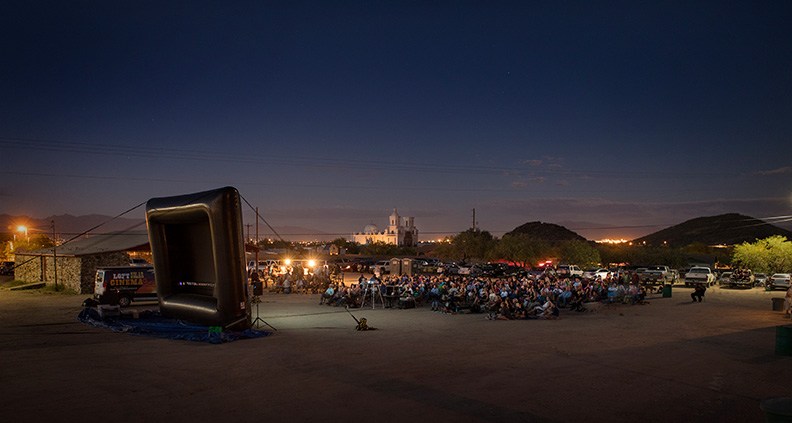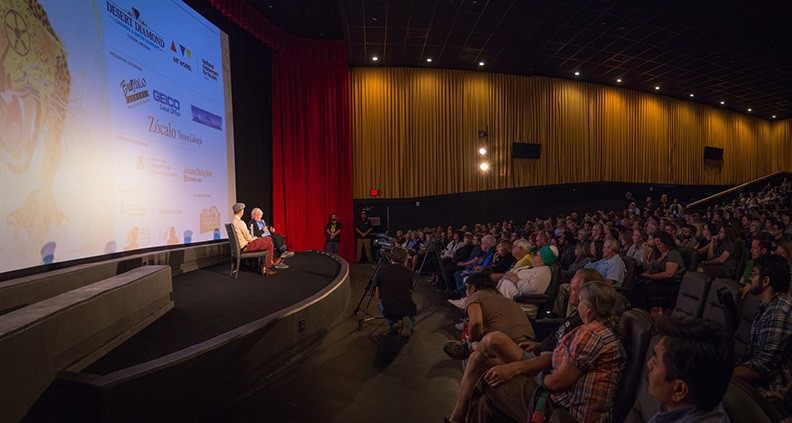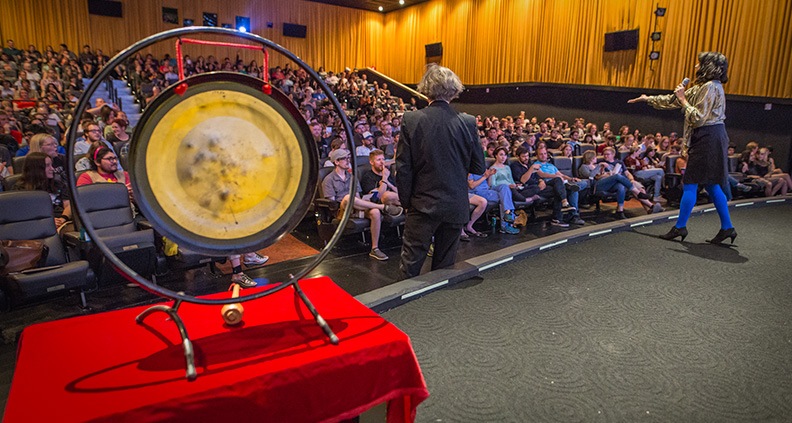From pastel skies to arid planes punctuated by cactus flowers and desert mesas, the American Southwest is inarguably one of the most cinematic looking of any geographic region. But the Southwest’s beauty as on-camera subject hasn’t always translated to a robust support for cinema itself, with long unpopulated distances separating major metropolitan areas and all the requisite difficulties of sustaining an engaged arts community in challenging times. One place where film culture is flourishing, however, is Tucson—home of the University of Arizona, the O.K. Corral and, most importantly for our purposes, The Loft Cinema. One of the most acclaimed independent art house theaters in the country, The Loft has been in operation since 1972, and as a nonprofit arts organization since 2002. It currently boasts over 4,500 members, and is itself a member of the Sundance Institute’s Art House Project. In addition to a full calendar’s worth of new film screenings, classic cinema and cult retrospectives, Q&A’s and special event, The Loft also produces a monthly short film competition, a kids’ film program and (last but certainly not least) a world famous mini-festival devoted to showcasing online cat videos. We recently spoke to Loft Program Director Jeff Yanc and Executive Director Peggy Johnson about the theater, its robust programming slate and what it takes to build a thriving local film community. Here’s the conversation:
THE LOFT THEATER
How long has The Loft Cinema been in business? The Loft Cinema has been in business 46 years. It became an art house in 1972, in a small theater on the University of Arizona campus that had previously shown porn. In 1991 it moved to a larger venue off-campus and was purchased and transitioned into a nonprofit in 2002. How many seats does the theater have? The Loft Cinema has three screens. The biggest is 370 seats and the two smaller screens have 85 seats and 98 seats. Tell us about the neighborhood. What’s the local film scene like? We’re located in Tucson, AZ, a city of about one million people located 60 miles north of the US-Mexico border. Tucson is a community filled with people passionate about supporting the arts and local institutions. It’s a progressive enclave with generally open-minded people. The film scene here has been through several booms of interest from Hollywood as a filming location—one in the 1950s and another in the 1980s. More recently, the film scene consists of local filmmakers and film students from the University of Arizona and Pima Community College, several of whom have gone on to national and international acclaim. The Loft Cinema also hosts one of the longest-running short film contests in the country, First Friday Shorts, in order to foster the scene. Are there any interesting stories behind the acquisition of your current theater space? A “For Sale” sign went up at The Loft in 2000, and a group of passionate film lovers started talking about how we could prevent it from closing. After talking with the owner of the building for two full years—during which the building was nearly sold to a buyer who planned to tear it down—he finally relented and sold the theatre to our group, who transitioned it into a nonprofit arts organization in November 2002. The building was constructed in the late 1960s as a 70mm road house cinema called the Showcase Cinema, later becoming part of the AMC chain. In 2012, we added a 3rd screen by purchasing, repurposing and converting an adjacent auto shop into a 98-seat screen. Do you have any unique regular programming that you do at the Loft? We host a multitude of recurring events that appeal to a wide variety of audiences, including our eight-day Loft Film Fest in November; our Loft Kids Fest in July, featuring nine days of free family films and activities; First Friday Shorts, a monthly short film contest for local filmmakers with hosts, live comedy and cash prizes; Essential Cinema, a free monthly series of classic art films with live introductions; Mondo Mondays, a weekly series of exploitation and B-movies with audience participation; movie Sing-A-Longs with goodie bags, costume contests and interactive fun; outdoor community screenings of new and classics films at offsite locations throughout Arizona, utilizing our solar-powered van, projection equipment and inflatable screen; and monthly midnight “shadow cast” screenings of The Rocky Horror Picture Show, which has played continuously at our theatre since 1978, which many claim is a U.S. record. What formats are you equipped to play? What sort of material do filmmakers need to provide to show their work in your theater? We pride ourselves on our ability to show pretty much everything. We most frequently play DCP because that’s now the industry standard, but we can also play digital files of all sorts (ProRes, MP4, etc.) and try to show films on film whenever we can. In 2016, we upgraded from a 35mm platter system to a changeover 35/70mm combo, both to return to our 70mm roots and to ensure many years of film access as studios and collectors become stingier about access to their products. We hope to add 16mm to our repertoire soon. What are some of the biggest challenges you’ve faced in running the theater? The biggest challenges involve the quantity of programming that we do, from first run films to special events, educational screenings, community partnerships and theater rentals. With the limited number of screens we have available, the sheer volume of programming we do requires constant strategizing. Other major challenges include studio clearance issues with competing theatre chains in our market related to the bigger, more “commercial” art film titles and trying to maintain our mission-driven programming by showing a diverse range of foreign films. The contemporary art film market for foreign language films seems to shrink each year, both in terms of box-office grosses and availability of titles from distributors. What programming choices have been unexpectedly successful? Also, have there been films you’ve programmed that you wish did better? The huge success of our twice-yearly screenings of The Cat Video Fest proved to be somewhat surprising, given that the program is mainly a collection of funny cat videos that are readily available to view online. But the instant and continued success of these screenings speaks volumes about the power of the theatrical experience and the appeal of sharing this kind of memorable “real life” moment with hundreds of other people, which is something that can’t be replicated online. On the flip side, there are many great, powerful, provocative films we have shown that have not drawn much of an audience, due to any number of factors. As an art house, these are often the films the staff are most passionate about, and that speak most directly to the reasons we love film as an art form. So to see those kinds of “small” films not find an audience is always a bit disappointing. But when one of these films somehow breaks through to a larger audience thanks to positive word-of-mouth and intangible “buzz,” it makes it all worthwhile. What’s your approach to social media and marketing? We rely primarily on social media, emails and our monthly printed film guide. We have about 20,000 email subscribers and print 20,000 film guides monthly that are mailed to homes and distributed throughout town. We also put money into Facebook posts and to a lesser extent Twitter and Instagram. We also advertise on the radio on our local NPR station, KXCI Community Radio and Downtown Radio stations. We rarely pay for print ads, but we do take them out to promote our films festivals. We have trades with many other local arts groups for advertising. Last year we partnered with 190 community groups on events. We’ve found that partnering with the community has brought in new audiences and exposed our audience to the great work being done by other organizations in Tucson. Why do you think the communal theatrical experience is still important? As society become more isolated because of the ubiquitous nature of cell phones and other devices, and as more video content becomes available on various streaming services, it becomes increasingly important that people have opportunities for social, interpersonal interaction. Movies are a great way for people to get out of their homes and become part of a community of friends and strangers who watch and experience films together on the big screen. This is especially true of the films offered by art houses, which tend to offer unique opportunities for conversation and debate. To learn more about The Loft Theater, what’s playing now and what’s coming up, check out the venue’s website. Do you have a favorite local art house you’d like to see profiled? Leave your suggestions in the comments. Learn how to become a Member of Film Independent by visiting our website. Be sure to follow us on Twitter, Facebook and Instagram and don’t forget to subscribe to Film Independent’s YouTube channel.


